SNVS174I February 2003 – February 2015 LP3852 , LP3855
PRODUCTION DATA.
- 1 Features
- 2 Applications
- 3 Description
- 4 Simplified Schematics
- 5 Revision History
- 6 Voltage Options
- 7 Pin Configuration and Functions
- 8 Specifications
- 9 Detailed Description
-
10Application and Implementation
- 10.1 Application Information
- 10.2
Typical Applications
- 10.2.1 Design Requirements
- 10.2.2 Detailed Design Procedure
- 10.2.3 Application Curves
- 11Power Supply Recommendations
- 12Layout
- 13Device and Documentation Support
- 14Mechanical, Packaging, and Orderable Information
Package Options
Mechanical Data (Package|Pins)
Thermal pad, mechanical data (Package|Pins)
Orderable Information
8 Specifications
8.1 Absolute Maximum Ratings
over operating free-air temperature range (unless otherwise noted) (1)| MIN | MAX | UNIT | ||
|---|---|---|---|---|
| Lead temperature (soldering, 5 sec.) | 260 | °C | ||
| Power dissipation(2) | Internally limited | |||
| Input supply voltage (survival) | –0.3 | 7.5 | V | |
| Shutdown input voltage (survival) | –0.3 | 7.5 | ||
| Output voltage (survival)(3), (4) | –0.3 | 6 | ||
| IOUT (survival) | Short-circuit protected | |||
| Maximum voltage for ERROR pin | VIN | |||
| Maximum voltage for SENSE pin | VOUT | |||
| Storage temperature, Tstg | –65 | 150 | °C | |
(1) Stresses beyond those listed under Absolute Maximum Ratings may cause permanent damage to the device. These are stress ratings only, which do not imply functional operation of the device at these or any other conditions beyond those indicated under Recommended Operating Conditions. Exposure to absolute-maximum-rated conditions for extended periods may affect device reliability.
(2) At elevated temperatures, devices must be derated based on package thermal resistance. The devices in TO-220 package must be derated at RθJA = 32°C/W (with 0.5 in2, 1-oz. copper area), junction-to-ambient (with no heat sink). The devices in the TO-263 surface-mount package must be derated at RθJA = 40.3°C/W (with 0.5 in2, 1-oz. copper area), junction-to-ambient. See Application and Implementation section.
(3) If used in a dual-supply system where the regulator load is returned to a negative supply, the output must be diode-clamped to ground.
(4) The output PMOS structure contains a diode between the IN and OUT terminals. This diode is normally reverse biased. This diode will get forward biased if the voltage at the output terminal is forced to be higher than the voltage at the input terminal. This diode can typically withstand 200 mA of DC current and 1 A of peak current.
8.2 ESD Ratings
| VALUE | UNIT | |||
|---|---|---|---|---|
| V(ESD) | Electrostatic discharge | Human-body model (HBM), per ANSI/ESDA/JEDEC JS-001(1) | ±2000 | V |
8.3 Recommended Operating Conditions
over operating free-air temperature range (unless otherwise noted)| MIN | NOM | MAX | UNIT | ||
|---|---|---|---|---|---|
| Input supply voltage(1) | 2.5 | 7 | V | ||
| Shutdown input voltage | −0.3 | 7 | |||
| Maximum operating current (DC) | 1.5 | A | |||
| Junction temperature | −40 | 125 | °C | ||
(1) The minimum operating value for VIN is equal to either [VOUT(NOM) + VDROPOUT] or 2.5 V, whichever is greater.
8.4 Thermal Information
| THERMAL METRIC(1) | LP3852/LP3855 | UNIT | |||
|---|---|---|---|---|---|
| NDC | KTT | NDH | |||
| 5 PINS | 5 PINS | 5 PINS | |||
| RθJA | Junction-to-ambient thermal resistance, High-K | 65.2 | 40.3 | 32 | °C/W |
| RθJC(top) | Junction-to-case (top) thermal resistance | 47.2 | 43.4 | 43.8 | |
| RθJB | Junction-to-board thermal resistance | 9.9 | 23.1 | 18.6 | |
| ψJT | Junction-to-top characterization parameter | 3.4 | 11.5 | 8.8 | |
| ψJB | Junction-to-board characterization parameter | 9.7 | 22 | 18 | |
| RθJC(bot) | Junction-to-case (bottom) thermal resistance | N/A | 1 | 1.2 | |
(1) For more information about traditional and new thermal metrics, see the IC Package Thermal Metrics application report, SPRA953.
8.5 Electrical Characteristics
Unless otherwise specified: VIN = VOUT(NOM) + 1 V, IOUT = 10 mA, COUT = 10 µF, VSD = 2 V, TJ = 25°C.| PARAMETER | TEST CONDITIONS | MIN(2) | TYP(1) | MAX(2) | UNIT | |
|---|---|---|---|---|---|---|
| VOUT | Output voltage tolerance(3) | VOUT +1 V ≤ VIN ≤ 7 V 10 mA ≤ IOUT ≤ 1.5 A |
–1.5% | 0 | 1.5% | |
| For –40°C ≤ TJ ≤ 125°C | –3% | 3% | ||||
| ΔVOUT/ΔVIN | Output voltage line regulation(3) | VOUT +1 V ≤ VIN ≤ 7 V | 0.02% | |||
| For –40°C ≤ TJ ≤ 125°C | 0.06% | |||||
| ΔVOUT/ΔIOUT | Output voltage load regulation(3) | 10 mA ≤ IOUT ≤ 1.5 A | 0.06% | |||
| For –40°C ≤ TJ ≤ 125°C | 0.12% | |||||
| VIN - VOUT | Dropout voltage TO-263 and TO-220(4) |
IOUT = 150 mA | 24 | 35 | mV | |
| For –40°C ≤ TJ ≤ 125°C | 45 | |||||
| IOUT = 1.5A | 240 | 280 | ||||
| For –40°C ≤ TJ ≤ 125°C | 380 | |||||
| Dropout voltage SOT(4), (5) |
IOUT = 150mA | 26 | 35 | |||
| For –40°C ≤ TJ ≤ 125°C | 45 | |||||
| IOUT = 1.5 A | 260 | 320 | ||||
| For –40°C ≤ TJ ≤ 125°C | 435 | |||||
| IGND | Ground pin current in normal operation mode | IOUT = 150 mA | 3 | 9 | mA | |
| For –40°C ≤ TJ ≤ 125°C | 10 | |||||
| IOUT = 1.5 A | 3 | 9 | ||||
| For –40°C ≤ TJ ≤ 125°C | 10 | |||||
| IGND | Ground pin current in shutdown mode | VSD ≤ 0.3V | 0.01 | 10 | µA | |
| -40°C ≤ TJ ≤ 85°C | 50 | |||||
| IOUT(PK) | Peak output current | VO ≥ VO(NOM) – 4% | 1.8 | A | ||
| SHORT CIRCUIT PROTECTION | ||||||
| ISC | Short circuit current | 3.2 | A | |||
| SHUTDOWN INPUT | ||||||
| VSDT | Shutdown threshold | VSDT Rising from 0.3 V until Output = ON |
1.3 | V | ||
| For –40°C ≤ TJ ≤ 125°C | 2 | |||||
| VSDT Falling from 2 V until Output = OFF |
1.3 | |||||
| For –40°C ≤ TJ ≤ 125°C | 0.3 | |||||
| TdOFF | Turnoff delay | IOUT = 1.5 A | 20 | µs | ||
| TdON | Turnon delay | IOUT = 1.5 A | 25 | µs | ||
| ISD | SD input current | VSD = VIN | 1 | nA | ||
| ERROR PIN | ||||||
| VT | Threshold | See(6) | 10% | |||
| For –40°C ≤ TJ ≤ 125°C | 5% | 16% | ||||
| VTH | Threshold hysteresis | See(6) | 5% | |||
| For –40°C ≤ TJ ≤ 125°C | 2% | 8% | ||||
| VEF(Sat) | ERROR pin saturation | Isink = 100 µA | 0.02 | V | ||
| For –40°C ≤ TJ ≤ 125°C | 0.1 | |||||
| Td | Flag reset delay | 1 | µs | |||
| Ilk | ERROR pin leakage current | 1 | nA | |||
| Imax | ERROR pin sink current | VError = 0.5 V | 1 | mA | ||
| AC PARAMETERS | ||||||
| PSRR | Ripple rejection | VIN = VOUT + 1 V COUT = 10 µF VOUT = 3.3V, f = 120 Hz |
73 | dB | ||
| VIN = VOUT + 0.5 V COUT = 10 µF VOUT = 3.3V, f = 120 Hz |
57 | |||||
| ρn(l/f) | Output noise density | f = 120 Hz | 0.8 | µV | ||
| en | Output noise voltage | BW = 10Hz – 100 kHz VOUT = 2.5 V |
150 | µV (rms) | ||
| BW = 300 Hz – 300 kHz VOUT = 2.5 V |
100 | |||||
(1) Typical numbers are at 25°C and represent the most likely parametric norm.
(2) Limits are specified by testing, design, or statistical correlation.
(3) Output voltage line regulation is defined as the change in output voltage from the nominal value due to change in the input line voltage. Output voltage load regulation is defined as the change in output voltage from the nominal value due to change in load current. The line and load regulation specification contains only the typical number. However, the limits for line and load regulation are included in the output voltage tolerance specification.
(4) Dropout voltage is defined as the minimum input to output differential voltage at which the output drops 2% below the nominal value. Dropout voltage specification applies only to output voltages of 2.5V and above. For output voltages below 2.5 V, the drop-out voltage is nothing but the input to output differential, since the minimum input voltage is 2.5 V.
(5) The SOT-223 package devices have slightly higher dropout due to increased bond wire resistance.
(6) ERROR threshold and hysteresis are specified as percentage of regulated output voltage. See ERROR Flag Operation.
8.6 Typical Characteristics
Unless otherwise specified: TJ = 25°C, COUT = 10 µF, CIN = 10 µF, SD pin is tied to VIN, VOUT = 2.5 V, VIN = VOUT(NOM) + 1 V, IOUT = 10 mA.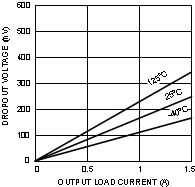
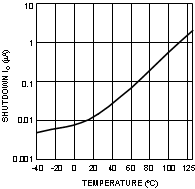
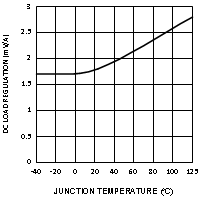
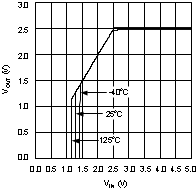
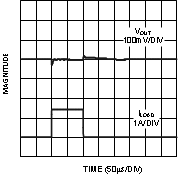
| CIN = COUT = 100 µF, OSCON | ||
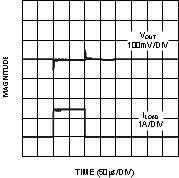
| CIN = COUT = 100 µF, Tantalum | ||
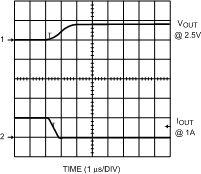
| CIN = 2 X 10 µF Ceramic | ||||
| COUT = 2 X 10µF Ceramic | ||||
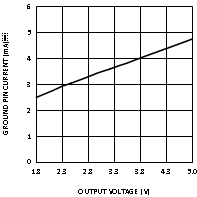
| IOUT = 1.5 A | ||
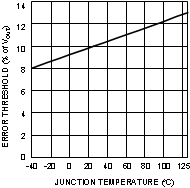
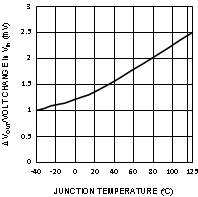
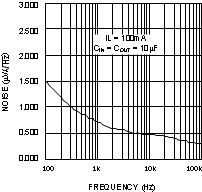
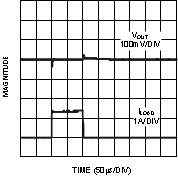
| CIN = COUT = 100 µF, POSCAP | ||
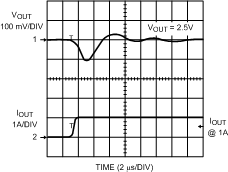
| CIN = 2 X 10 µF Ceramic | ||
| COUT = 2 X 10µF Ceramic | ||